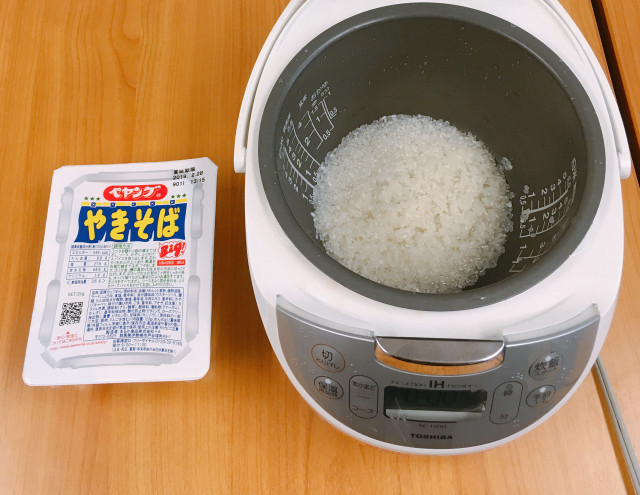
Just because two things taste great, doesn’t mean they always taste great together.
One day, Mr. Sato was eating a pack of Peyang instant fried noodles when it dawned on him: these so-called “fried noodles” aren’t fried at all!
He was right. Like most instant noodles, Peyang is simply made by soaking in hot water for a few minutes, kind of like…rice.
The carb-fueled gears in Mr. Sato’s head began spinning wildly as he began to grasp the importance of this correlation.
In the end he hypothesized that if rice is yummy and instant noodles are really yummy, then rice cooked along with instant noodles should be exponentially yummy, perhaps even more than the sum of its parts.
This was an exciting revelation, so Mr. Sato wasted no time formulating a recipe and got to work. We’d now like to share his findings so that everyone can unlock this flavor potential.
Mr. Sato’s Rice and Peyang
Ingredients
- Peyang Instant Yakisoba with Sauce
- Rice
- Water
First, add an amount of rice that you feel would match the Peyang noodles evenly. Then, add the water needed to cook it. After that, just chuck on your brick of dried noodles.
Don’t forget to add the dried toppings.
You’re probably exhausted at this point in the recipe, so you might want to take a break and watch a newsreel or something. Once you’ve regained your strength, pour on the sauce.
Normally, the sauce is added after the noodles are softened, but this way the sauce will be cooked into the rice for a deeper flavor.
Mr. Sato found the biggest challenge was balancing the amount of water. Too much water would dilute the sauce and make it too weak. Too little water and the rice wouldn’t cook properly.
Deciding to err on the side of flavor, he held back on the water, making sure there was just enough to cook the rice and no more. After that, all that was left was to close the lid and hit “cook.”
It should take about 30 minutes for the rice cooker to work its magic, so why not watch this video of 13 Japanese Pokemon songs back-to-back and watch the time fly by!
By the time the Machoke Movers commercial wrapped up, so too did Mr. Sato’s Rice and Peyang. He lifted the lid and saw…
▼ Mr. Sato: “Oh, I wasn’t expecting that.”
It looked as if the upper half of the Peyang brick didn’t soften at all. Clearly, Mr. Sato had given into the fear of weak sauce and it cost him dearly in the form of tender noodles. Nevertheless he continued forward in the name of science.
He placed a small sample of Rice and Peyang into a bowl with a little garnish for a tasting and took a bite. The crunchy noodles were disconcerting but the Peyang taste had definitely married with the rice, and it was damn good.
But it was also kind of weak. So, even though Mr. Sato made the poor decision of not using enough water, his fear of a weak sauce still came true. The entire scientific foundation of Rice and Peyang appeared to be crumbling before Mr. Sato’s eyes, but he was ready with an ace up his sleeve.
Luckily, just this past summer Peyang began selling bottles of their sauce separately for those wanting to boost their instant noodles or add its unique flavor to other foods. In this case Mr. Sato was doing both and it worked!
So while Mr. Sato’s first Rice and Peyang was less than perfect, the concept was there. Learning from his mistakes, anyone who attempts this dish should consider adding more than the usual amount of water, but also adding some extra bottled Peyang to compensate and achieve that strong cooked-in flavor.
Be careful not to use too much of either though, or you risk drowning out all other flavors. Like anything in life, moderation is the key.
Also, if Mr. Sato’s Rice and Peyang recipe was a little too simple for your liking, you can always take your instant noodle cooking to the next level by attempting our homemade Sour Cream and Onion Pringles yakisoba.
Images: SoraNews24
[ Read in Japanese ]

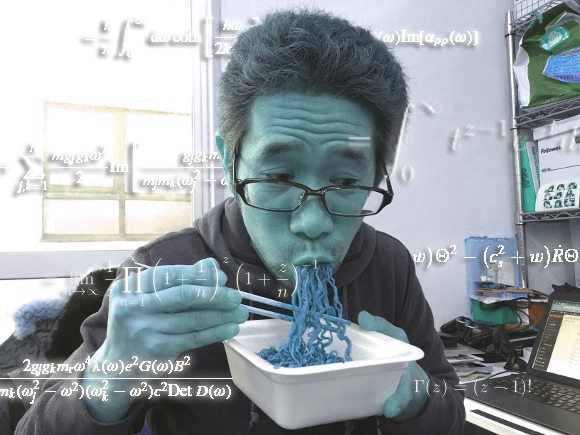
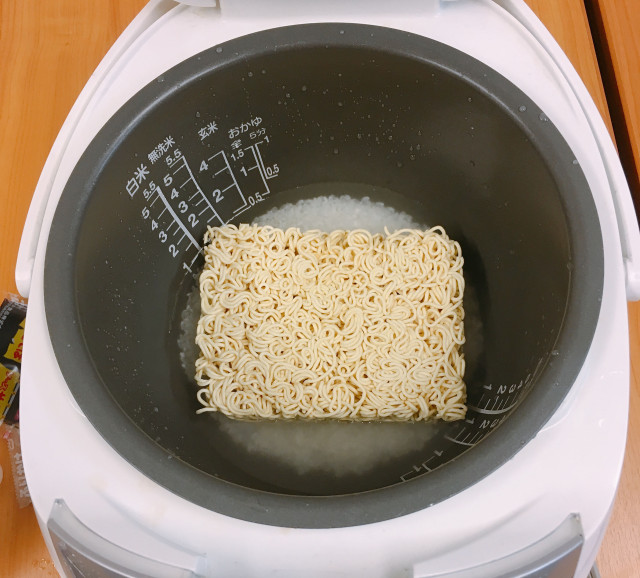
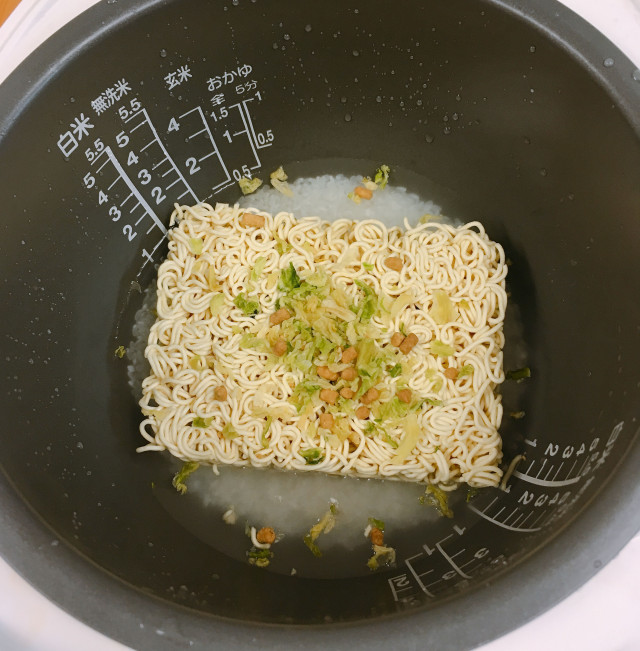

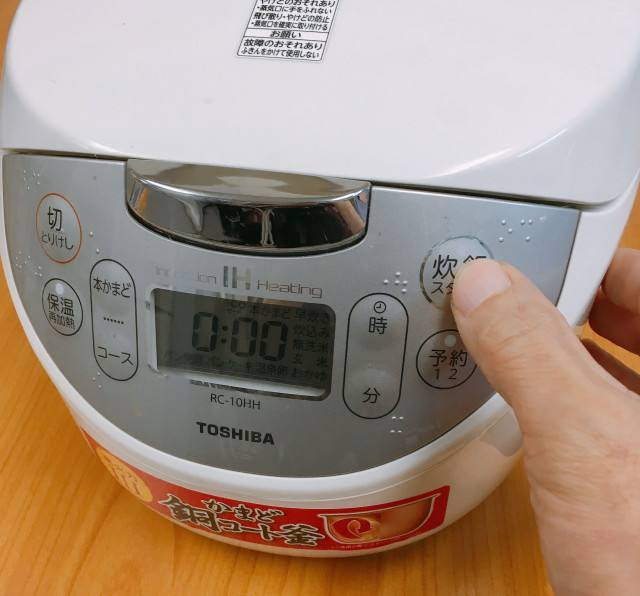
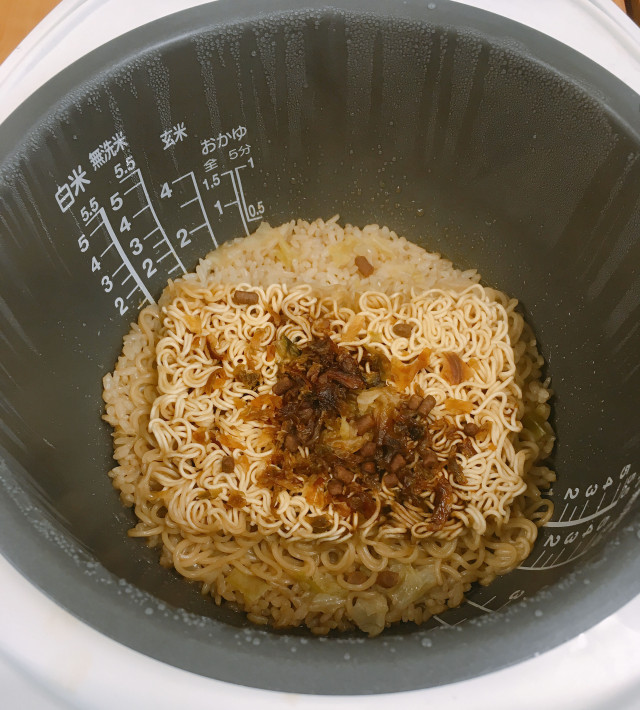

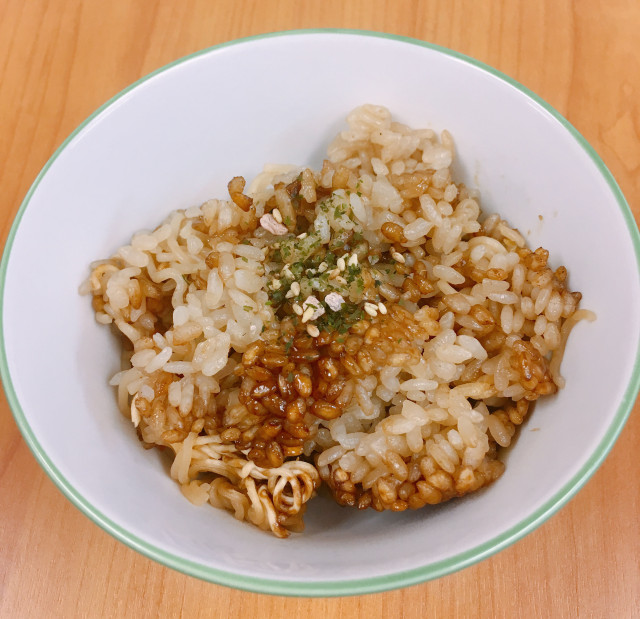
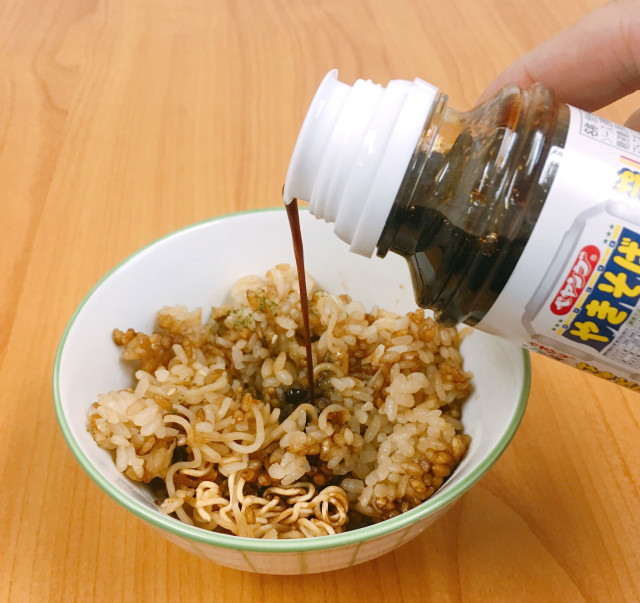
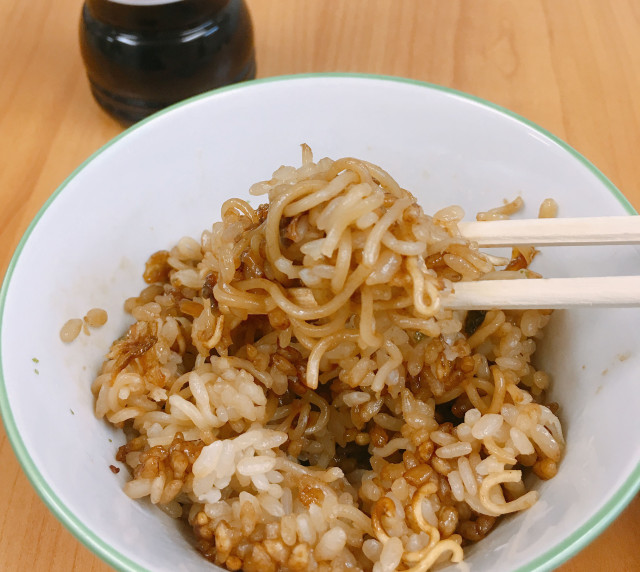
 People affected by Hokkaido earthquake stock up on everything but Peyang’s ultra-spicy noodles
People affected by Hokkaido earthquake stock up on everything but Peyang’s ultra-spicy noodles Can a famous Japanese hypnotist make us eat super spicy instant noodles?【Experiment】
Can a famous Japanese hypnotist make us eat super spicy instant noodles?【Experiment】 How to make your own Pringles-flavor instant noodles【SoraKitchen】
How to make your own Pringles-flavor instant noodles【SoraKitchen】 Mr. Sato broadens his home drinking horizons at Kaldi【Japan’s Best Home Senbero】
Mr. Sato broadens his home drinking horizons at Kaldi【Japan’s Best Home Senbero】 Gamer-friendly, non-instant yakisoba you can eat with your fingers【Sora Kitchen】
Gamer-friendly, non-instant yakisoba you can eat with your fingers【Sora Kitchen】 Foreigner’s request for help in Tokyo makes us sad for the state of society
Foreigner’s request for help in Tokyo makes us sad for the state of society Seaside scenery, history, and so many desserts on Yokohama’s Akai Kutsu【Japan Loop Buses】
Seaside scenery, history, and so many desserts on Yokohama’s Akai Kutsu【Japan Loop Buses】 Japanese city loses residents’ personal data, which was on paper being transported on a windy day
Japanese city loses residents’ personal data, which was on paper being transported on a windy day Should you add tartar sauce to Japanese curry rice? CoCo Ichi makes diners an unusual offer
Should you add tartar sauce to Japanese curry rice? CoCo Ichi makes diners an unusual offer Harajuku Station’s beautiful old wooden building is set to return, with a new complex around it
Harajuku Station’s beautiful old wooden building is set to return, with a new complex around it Akihabara pop-up shop sells goods made by Japanese prison inmates
Akihabara pop-up shop sells goods made by Japanese prison inmates Red light district sushi restaurant in Tokyo shows us just how wrong we were about it
Red light district sushi restaurant in Tokyo shows us just how wrong we were about it French Fries Bread in Tokyo’s Shibuya becomes a hit on social media
French Fries Bread in Tokyo’s Shibuya becomes a hit on social media Ghibli Park now selling “Grilled Frogs” from food cart in Valley of Witches
Ghibli Park now selling “Grilled Frogs” from food cart in Valley of Witches McDonald’s Japan releases a pancake pie for new retro kissaten coffeeshop series
McDonald’s Japan releases a pancake pie for new retro kissaten coffeeshop series McDonald’s new Happy Meals offer up cute and practical Sanrio lifestyle goods
McDonald’s new Happy Meals offer up cute and practical Sanrio lifestyle goods Japanese ramen restaurants under pressure from new yen banknotes
Japanese ramen restaurants under pressure from new yen banknotes Studio Ghibli releases new action figures featuring Nausicaä of the Valley of the Wind characters
Studio Ghibli releases new action figures featuring Nausicaä of the Valley of the Wind characters New private rooms on Tokaido Shinkansen change the way we travel from Tokyo to Kyoto
New private rooms on Tokaido Shinkansen change the way we travel from Tokyo to Kyoto Tokyo Tsukiji fish market site to be redeveloped with 50,000-seat stadium, hotel, shopping center
Tokyo Tsukiji fish market site to be redeveloped with 50,000-seat stadium, hotel, shopping center All-you-can-drink Starbucks and amazing views part of Tokyo’s new 170 meter-high sky lounge
All-you-can-drink Starbucks and amazing views part of Tokyo’s new 170 meter-high sky lounge Beautiful Ghibli sealing wax kits let you create accessories and elegant letter decorations【Pics】
Beautiful Ghibli sealing wax kits let you create accessories and elegant letter decorations【Pics】 Studio Ghibli releases Kiki’s Delivery Service chocolate cake pouches in Japan
Studio Ghibli releases Kiki’s Delivery Service chocolate cake pouches in Japan New definition of “Japanese whiskey” goes into effect to prevent fakes from fooling overseas buyers
New definition of “Japanese whiskey” goes into effect to prevent fakes from fooling overseas buyers Our Japanese reporter visits Costco in the U.S., finds super American and very Japanese things
Our Japanese reporter visits Costco in the U.S., finds super American and very Japanese things Studio Ghibli unveils Mother’s Day gift set that captures the love in My Neighbour Totoro
Studio Ghibli unveils Mother’s Day gift set that captures the love in My Neighbour Totoro More foreign tourists than ever before in history visited Japan last month
More foreign tourists than ever before in history visited Japan last month New Pokémon cakes let you eat your way through Pikachu and all the Eevee evolutions
New Pokémon cakes let you eat your way through Pikachu and all the Eevee evolutions Sales of Japan’s most convenient train ticket/shopping payment cards suspended indefinitely
Sales of Japan’s most convenient train ticket/shopping payment cards suspended indefinitely Sold-out Studio Ghibli desktop humidifiers are back so Totoro can help you through the dry season
Sold-out Studio Ghibli desktop humidifiers are back so Totoro can help you through the dry season Japanese government to make first change to romanization spelling rules since the 1950s
Japanese government to make first change to romanization spelling rules since the 1950s Ghibli founders Toshio Suzuki and Hayao Miyazaki contribute to Japanese whisky Totoro label design
Ghibli founders Toshio Suzuki and Hayao Miyazaki contribute to Japanese whisky Totoro label design Doraemon found buried at sea as scene from 1993 anime becomes real life【Photos】
Doraemon found buried at sea as scene from 1993 anime becomes real life【Photos】 Tokyo’s most famous Starbucks is closed
Tokyo’s most famous Starbucks is closed One Piece characters’ nationalities revealed, but fans have mixed opinions
One Piece characters’ nationalities revealed, but fans have mixed opinions We asked a Uniqlo employee what four things we should buy and their suggestions didn’t disappoint
We asked a Uniqlo employee what four things we should buy and their suggestions didn’t disappoint Princesses, fruits, and blacksmiths: Study reveals the 30 most unusual family names in Japan
Princesses, fruits, and blacksmiths: Study reveals the 30 most unusual family names in Japan Mr. Sato shows us what happens when you try to cook rice with only eggs 【SoraKitchen】
Mr. Sato shows us what happens when you try to cook rice with only eggs 【SoraKitchen】 This super easy cold Korean spicy ramen dish will make summer 100 times more delicious
This super easy cold Korean spicy ramen dish will make summer 100 times more delicious We make delicious French toast using a LOT of Japanese custard pudding
We make delicious French toast using a LOT of Japanese custard pudding Crazy Tokyo restaurant offers a 7.3-pound tempura rice bowl, so of course we had to eat it!
Crazy Tokyo restaurant offers a 7.3-pound tempura rice bowl, so of course we had to eat it! What happens when you cook beer with potato chips in a rice cooker?
What happens when you cook beer with potato chips in a rice cooker? Yakiniku Like in Tokyo starts serving up solo shabu shabu hot pot, and we tried it
Yakiniku Like in Tokyo starts serving up solo shabu shabu hot pot, and we tried it Using Starbucks Japan’s hot water to make ochazuke, one of Japan’s best comfort foods
Using Starbucks Japan’s hot water to make ochazuke, one of Japan’s best comfort foods Bread, noodles, and rice. We try ALL THE CARBS together with interesting results 【Rocket Kitchen】
Bread, noodles, and rice. We try ALL THE CARBS together with interesting results 【Rocket Kitchen】 You can make rice with tapioca bubble tea, and it’s surprisingly tasty【SoraKitchen】
You can make rice with tapioca bubble tea, and it’s surprisingly tasty【SoraKitchen】 “Grilled corn” and “gyoza” flavored shaved ice sold at Saitama cafe
“Grilled corn” and “gyoza” flavored shaved ice sold at Saitama cafe Nissin to sell rice bowls covered in those little “mystery meat” cubes from Cup Noodle
Nissin to sell rice bowls covered in those little “mystery meat” cubes from Cup Noodle Behold the fluffiest rice omelet in Tokyo…possibly the world!
Behold the fluffiest rice omelet in Tokyo…possibly the world! We get to be (probably) the first ever to try Nissin Cup Noodle’s latest creation: Gyoza ramen!
We get to be (probably) the first ever to try Nissin Cup Noodle’s latest creation: Gyoza ramen! Tokyo restaurant offers “DIY Tempura Bowls,” so of course we had to go check it out
Tokyo restaurant offers “DIY Tempura Bowls,” so of course we had to go check it out Japanese chain Bikkuri Donkey’s enormous salad almost beats Mr. Sato, but not because of its size
Japanese chain Bikkuri Donkey’s enormous salad almost beats Mr. Sato, but not because of its size We find Italian Soba at an Aomori fish market that insisted it’s perfect for the beach
We find Italian Soba at an Aomori fish market that insisted it’s perfect for the beach
Leave a Reply